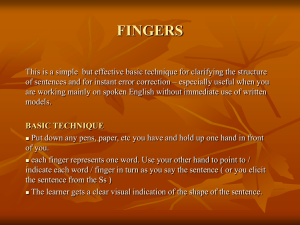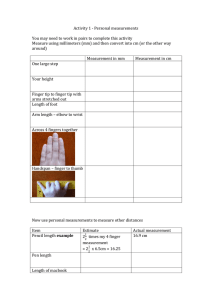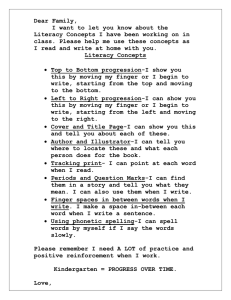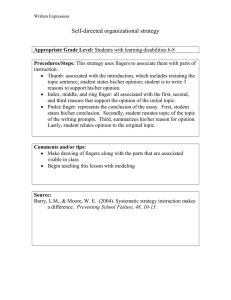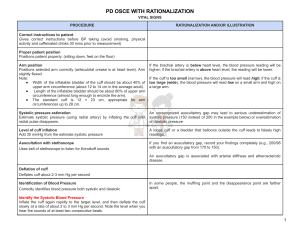Neurological assessment
advertisement
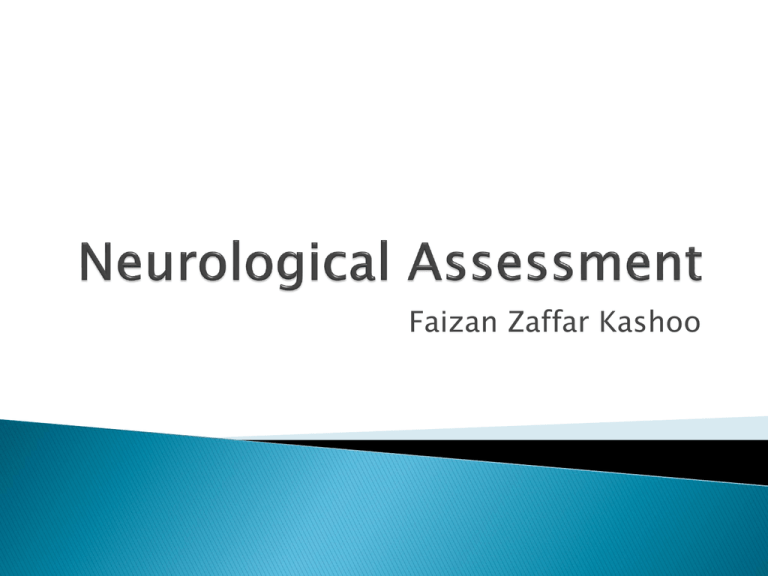
Faizan Zaffar Kashoo 1. 2. 3. 4. 5. 6. 7. Mental Status Cranial Nerves Motor Coordination and Gait Reflexes Sensory Special Tests Mini Mental Status Examination Important observations Ptosis (III) Facial Droop or Asymmetry (VII) Hoarse Voice (X) Articulation of Words (V, VII, X, XII) Abnormal Eye Position (III, IV, VI) Abnormal or Asymmetrical Pupils (II, III) Observation Involuntary Movements Muscle Symmetry ◦ Left to Right ◦ Proximal vs. Distal Atrophy ◦ Pay particular attention to the hands, shoulders, and thighs. Gait Ask the patient to relax. Flex and extend the patient's fingers, wrist, and elbow. Flex and extend patient's ankle and knee. There is normally a small, continuous resistance to passive movement. Observe for decreased (flaccid) or increased (rigid/spastic) tone. Test strength by having the patient move against your resistance. Always compare one side to the other. Grade strength on a scale from 0 to 5 "out of five": ◦ ◦ ◦ ◦ ◦ ◦ ◦ ◦ ◦ ◦ ◦ ◦ ◦ ◦ Flexion at the elbow (C5, C6, biceps) Extension at the elbow (C6, C7, C8, triceps) Extension at the wrist (C6, C7, C8, radial nerve) Squeeze two of your fingers as hard as possible ("grip," C7, C8, T1) Finger abduction (C8, T1, ulnar nerve) Oppostion of the thumb (C8, T1, median nerve) Flexion at the hip (L2, L3, L4, iliopsoas) Adduction at the hips (L2, L3, L4, adductors) Abduction at the hips (L4, L5, S1, gluteus medius and minimus) Extension at the hips (S1, gluteus maximus) Extension at the knee (L2, L3, L4, quadriceps) Flexion at the knee (L4, L5, S1, S2, hamstrings) Dorsiflexion at the ankle (L4, L5) Plantar flexion (S1) Ask the patient to stand for 20-30 seconds with both arms straight forward, palms up, and eyes closed. Instruct the patient to keep the arms still while you tap them briskly downward. The patient will not be able to maintain extension and supination (and "drift into pronation) with upper motor neuron disease. Rapid Alternating Movements Ask the patient to strike one hand on the thigh, raise the hand, turn it over, and then strike it back down as fast as possible. Ask the patient to tap the distal thumb with the tip of the index finger as fast as possible. Ask the patient to tap your hand with the ball of each foot as fast as possible. Ask the patient to touch your index finger and their nose alternately several times. Move your finger about as the patient performs this task. Hold your finger still so that the patient can touch it with one arm and finger outstretched. Ask the patient to move their arm and return to your finger with their eyes closed. Ask the patient to place one heel on the opposite knee and run it down the shin to the big toe. Repeat with the patient's eyes closed. Be prepared to catch the patient if they are unstable. Ask the patient to stand with the feet together and eyes closed for 5-10 seconds without support. The test is said to be positive if the patient becomes unstable (indicating a vestibular or proprioceptive problem). Ask the patient to: ◦ ◦ ◦ ◦ ◦ ◦ ◦ Walk across the room, turn and come back Walk heel-to-toe in a straight line Walk on their toes in a straight line Walk on their heels in a straight line Hop in place on each foot Do a shallow knee bend Rise from a sitting position The patient must be relaxed and positioned properly before starting. Reflex response depends on the force of your stimulus. Use no more force than you need to provoke a definite response. Reflexes can be reinforced by having the patient perform isometric contraction of other muscles (clenched teeth). Reflexes should be graded on a 0 to 4 "plus" scale:

